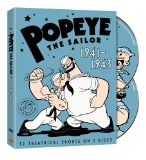| Reviews & Columns |
|
Reviews DVD TV on DVD Blu-ray 4K UHD International DVDs In Theaters Reviews by Studio Video Games Features Collector Series DVDs Easter Egg Database Interviews DVD Talk Radio Feature Articles Columns Anime Talk DVD Savant Horror DVDs The M.O.D. Squad Art House HD Talk Silent DVD
|
DVD Talk Forum |
|
|
| Resources |
|
DVD Price Search Customer Service #'s RCE Info Links |
|
Columns
|
|
|
Popeye the Sailor: 1941-1943, Vol. 3
THE SHOW:
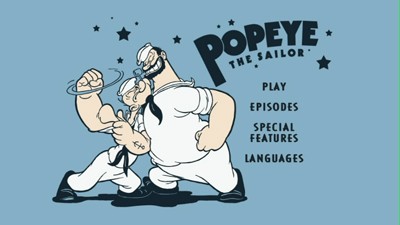
When last we left our scrappy seaman, with last spring's Popeye the Sailor, 1938-1940: Volume Two, I was lamenting that the evolution of the character, spurred on by increasing popularity and a need to fill a production schedule, had maybe gone a little too far from the core concept. The early cartoons, pre-1938, as seen in Volume One of this exceptional Warner Bros.' DVD series, had an addictive, hypnotic violence in the never-ending struggle between Popeye and Bluto that had, by Volume Two, given way to less edgy plots involving other characters and scenarios. Unfortunately, this is a lasting development that we will see emerge again in Popeye the Sailor, 1941-1943: Volume Three, but we will also be treated to yet another sea change for the character that proves, just like in his cartoons, Popeye can sometimes be down, but the old salt is never out.
Popeye the Sailor, 1941-1943: Volume Three is a two-disc set with thirty-two cartoons, and the first disc starts off strong with a couple of Poopdeck Pappy cartoons. Father and son switch roles in "Problem Pappy" and "Quiet! Pleeze" as Popeye tries to reign in the renegade senior citizen in the former and the entire world in the latter, going to great lengths to keep the hungover Pappy from being disturbed. These, along with the third cartoon, "Olive's Sweepstake Ticket," hearken back to the influential silent film comedies of Harold Lloyd and Buster Keaton, a staple inspiration for the Fleischer animation team and the Popeye short subjects. In "Olive's Sweepstake Ticket," when Popeye chases the errant piece of paper across the city, it's an extreme yet logical extension of the complicated stunt gags pioneered in live-action comedies, but taking them to lengths only possible in animation. The results are hilarious.
Popeye doesn't fare so well in some of the other hijinks the Fleischers cook up for him, though. Seeing him battle a bug in "Flies Ain't Human" is beneath the spinach eater, and I've grown increasingly less fond of the cartoons where he is coupled with fairy tale characters. "Popeye Meets Rip Van Winkle," in which Popeye contends with all manner of obstacles, including bowling elves, to keep the snoozing Van Winkle from being awoken is absurd in the wrong ways and suffers all the more in that we just saw Popeye trying to help someone stay asleep three cartoons prior.
Midway through DVD 1 of Volume 3, things begin to shift. World War II had begun, and like many in the motion picture industry, the Fleischer Studios wanted to do their part for the war effort. So, Popeye joins the Navy, beginning with "The Mighty Navy." The comedy here first comes from Popeye, the ultimate iconoclast, trying to fit into the strict regimen of his chosen service before eventually earning his hero's stripes by downing some spinach and taking on the enemy all by his lonesome. This basic plot idea will be one of the regular formulas returned to in the many wartime cartoons on this set. Other shorts, such as "Kickin' the Conga Round" and "Olive Oyl and Water Don't Mix," will establish a second Navy-era formula, with Popeye and Bluto being on the same ship and doing what they do best: battling over their lady. "Many Tanks" even sees Bluto as a soldier in the Army who can't get a furlough, and so he forces Navy man Popeye to swap uniforms in order to sneak off for some lovin'.
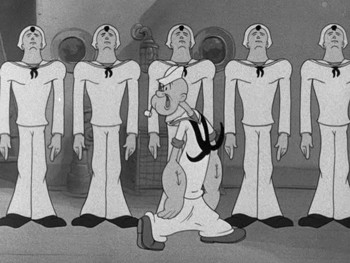
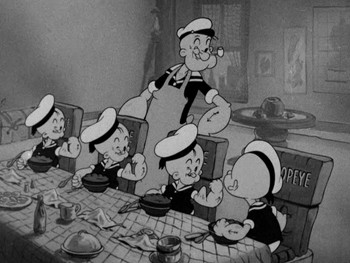
Around this time, we are also introduced to Popeye's quartet of identical nephews, coming first in the self-titled "Pip-Eye, Pup-Eye, Poop-Eye an' Peep-Eye" and then reappearing in several other cartoons. These little guys actually first appeared on a previous set as an element of Olive Oyl's dream about a future with Popeye where these rapscallions are their sons. Their return as his nephews is never explained, and though there are some laughs to be had by these mischievous little Popeyes running around and torturing their uncle, to be honest, they are never quite as endearing as that other youngster, Swee' Pea. One of the best cartoons on DVD 1 is "Child Psykolojiky," with Swee' Pea entering into a brawl with Poopdeck Pappy while Popeye is away. I don't think Popeye could have held his own in their battle, anyway, seeing what a sissy he's become! Don't believe me? Just look at the trouble he has chasing the toddler around in "Baby Wants a Bottleship."
Recently, when I reviewed the Looney Tunes: Golden Collection, Vol. 6, I noted that WWII had added some vigor to the humor in the Warner cartoons of the era, and I think the same has happened for Popeye. Though the formula isn't entirely dismantled, this new setting and new targets, no matter how regrettable their portrayals now, have an added verve that had been somewhat lacking in the series for a couple of years. This, too, would fade, but not necessarily by repetition alone.
There was one other major change in the Popeye series that happened during the time frame of this set, and it comes two cartoons into disc 2. With the rarely seen "You're a Sap, Mr. Jap," a racially charged war 'toon based on a Spike Jones song, the production of the cartoons moved to the Paramount in-house animation department, later known as Famous Studios. The change is immediately noticeable. Though all of the characters look essentially the same, the ink line grows thicker and the movements are smoother, less rubbery. It's not necessarily a bad thing, some may even prefer this style. It just seems less on-the-edge, more like what other studios were doing at the time, and in keeping with the shift, the humor also seems a lot safer, more cliché. That could just be because these are the cartoons that were the most recycled and mined for gags in post-War productions; then again, Popeye in drag pretending to be Bluto's nurse in "Too Weak to Work" isn't exactly the greatest or most original idea. Also, what's with all the talking birds in "Alona on the Sarong Seas" and "Jolly Good Furlough"? "Ration Fer the Duration" and "The Hungry Goat" even come off like the animators are cribbing from discarded Looney Tunes scripts rather than sticking to the Popeye model.
Though the analogy is kind of a stretch, it's like how when a TV show starts off as an independent project with a lower budget and the freedom of having less eyes on the product, and then when it becomes more successful, the producers start to show off a bit, displaying increased production values and by having more, they seem to try less. (You know, like how the clothes on Sex & the City got really outrageous somewhere around season 3.) It's not worse or bad, just not the same. The innocence is gone.
Most of DVD 2 continues the wartime effort. Popeye and Bluto are still serving their country, and even when not on duty, the plots somehow touch on the times, such as the shipbuilding in "A Hull of a Mess." "Me Musical Nephews" even has Popeye returning home after being away, and includes a scene where the war-weary sailor jumps to attention after being disturbed in his slumber. Post-traumatic stress? The rest of the cartoon is about the scamps refusing to go to bed. Popeye later gets a second leave that is disrupted by his nephews in "Jolly Good Furlough."
My favorite from this later period is probably "Seein' Red, White 'n' Blue." It starts with a more classic set-up pitting Bluto and Popeye against one another: the brute is drafted, doesn't want to go to war, and tries to trick his draft officer, Popeye, into letting him off the hook. Various violent "accidents" occur before Popeye crashes into a secret enclave of Japanese spies passing themselves off as orphans. In this, the earlier style meets the current style, as Bluto and Popeye team up to stop these interlopers, and the whole thing descends into comedy chaos--including relieving Hitler of his moustache!
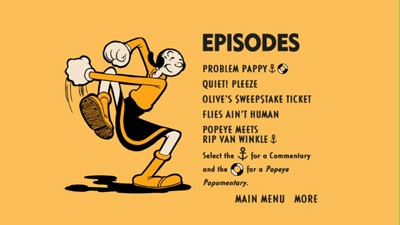
The full list of cartoons on DVD 1:
* Problem Pappy (commentary by historian Jerry Beck and Steve Waldman, son of director/animator Myron Waldman) * Quiet! Pleeze * Olive's Sweepstake Ticket * Flies Ain't Human * Popeye Meets Rip Van Winkle (commentary by Beck and Waldman) * Olive's Boithday Presink * Child Psykolojiky * Pest Pilot * I'll Never Crow Again * The Mighty Navy (commentary by Beck and animation director Bob Jacques) * Nix on Hypnotricks * Kickin' the Conga Around * Blunder Below * Fleets of Stren'th * Pip-Eye, Pup-Eye, Poop-Eye an' Peep-Eye * Olive Oyl and Water Don't Mix
The full list of cartoons on DVD 2:
* Many Tanks * Baby Wants a Bottleship * You're A Sap, Mr. Jap * Alona on the Sarong Seas * A Hull of a Mess * Scrap the Japs * Me Musical Nephews (commentary by John Kricfalusi, Eddie Fitzgerald, and Kali Fontecchio) * Spinach Fer Britain * Seein' Red, White 'n' Blue (commentary by animator Mark Kausler) * Too Weak to Work (commentary by Bob Jacques) * A Jolly Good Furlough * Ration Fer the Duration * The Hungry Goat (commentary by Jerry Beck) * Happy Birthdaze * Wood-Peckin' * Cartoons Ain't Human
By the way, does anyone else find it surprising that despite the jeep's the Army used being named after Popeye's magical pet, the little guy doesn't show up in any of these pictures?
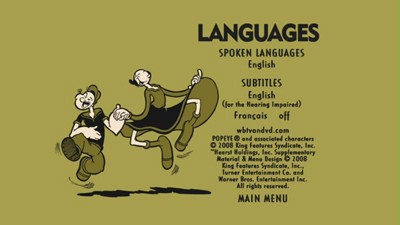
THE DVD
Video:
These cartoons are all full frame, and I have to say, of all the sets, Popeye the Sailor, 1941-1943: Volume Three is a letdown in this department. It kind of seems like knowing that there would be diminishing returns in terms of sales as the DVD series wore on, the studio decided to scale back their restoration efforts and run the material in whatever state was available. Frequent scratches and faded graytones mar the cartoons, and there are also multiple instances of poor resolution, like one is squinting and viewing the cartoons at a distance. Granted, these cartoons are nearly 70 years old, and I am willing to accept a less-than-perfect transfer, but seeing how nice Volume One looked, Volume Three doesn't measure up.
Somewhat converse to the actual quality of content, it looks to me like the later Famous Studios cartoons are better preserved than the earlier, superior Fleischer 'toons. They still have many problems, but the overall clarity of a lot of them is markedly better than what precedes them. Then again, it might just be the luck of the draw, as "Ration Fer the Duration" is just as bad as any of the earlier entries.
Sound:
The soundtracks for the toons are of similar quality to older sets. Mixed in mono, the levels are clean and consistent, and there is no hiss or mismatched tones.
There are optional English subtitles for the deaf and hearing impaired and also French subtitles.
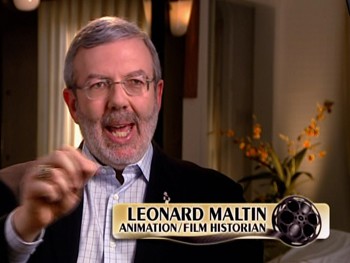
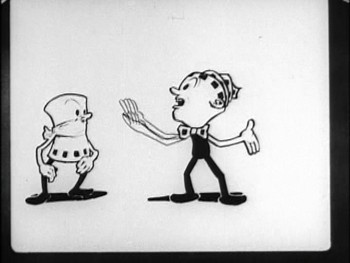
Extras:
The DVD packaging for Popeye the Sailor, 1941-1943: Volume Three continues the quality design of the previous sets, featuring gorgeous artwork by cartoonist Stephen DeStefano. The cardboard book holding the two discs is of a standard keepcase size, with a staggered double tray. It then fits inside a sturdy outer slipcase.
Both discs have a handful of audio commentaries on individual cartoons, which I have indicated in the title lists above.
DVD 1's bonus section leads with three "Popeye Popumentaries," short featurettes about specific topics in relation to cartoons on the disc. This time around, the choices are actually pretty solid. "Directing the Sailor: The Art of Myron Waldman" (7 minutes, 20 seconds) features an interview with the longtime Fleischer animator and his wife Rosalie, who also worked in the animation department as an opaquer and a timing consultant. This is followed by "Popeye: The Mighty Ensign" (7:45), a look at Popeye's war years, and "Pip-Eye, Pup-Eye, Poop-Eye an' Peep-Eye: Chips Off the Old Salt" (3:40), a brief discussion of Popeye's nephews. These featurettes, as well as the longer documentary on DVD 2, include input from commentators we have seen on the other volumes (usually from the same interviews) and include folks such as historians Steve Stanchfield, Jerry Beck, Glenn Mitchell, Will Friedwald, Mark Langer, Donald Crafton, Leonard Maltin, and Harvey Deneroff; experimental animators Bill Plympton, George Griffin, and Michael Sporn; mainstream animators Mark Kausler, Eric Goldberg, and Bob Jacques; and others.
DVD 1 has three early Fleischer Out of the Inkwell shorts: "The Clown's Little Brother" (1920), "The Cartoon Factory" (1924), and "Koko Needles the Boss" (1927). All three of these shorts are presented as silent features with no accompanying music, and they have a combination of animation and live action, with Koko the Clown interacting with his creator, Max Fleischer.
DVD 2 has a 27-minute, 40-second documentary called "Forging the Frame: The Roots of Animation, 1921-1930". It's an excellent piece, showing many rare clips from early cartoons and tracing the rise of the art form from its very early days through later competition and innovation, and on into the sound era. The pioneering Fleischer Inkwell cartoons are discussed a length, including references to the bonus shorts on DVD 1, and we also get extended looks at early Felix the Cat shorts, Walter Lantz's Dinky Doodle series, and the Paul Terry and Walt Disney studios. In line with this, we also get a bonus short from 1929, "Finding His Voice,", a Fleischer cartoon created to showcase new sound technology, featuring two strips of film, the gagged Mutie and the talkative Talkie, looking at the machines that are making one obsolete and giving the other new life.
DVD 2 also has trailers for other DVDs: the latest Looney Tunes Golden Collection, the new reissue of It's the Great Pumpkin, Charlie Brown, and volume 2 of Popeye.
FINAL THOUGHTS:
Popeye the Sailor, 1941-1943: Volume Three is not of the exceptional quality of the previous two volumes. It's somewhat understandable. The muscular sailor did have a war to contend with, not to mention a complete creative change when his production moved from the Fleischer Studios to Paramount's Famous Studios. Still, for a little over half this set, the series is in fine form and the cartoons provide plenty of laughs; the proceedings only get a little stale as we near the end of DVD 2. The extras on the two discs are really good, too, which somewhat balances out the poor quality of a lot of the transfers. I'm really torn by this one: there is a lot to like, and a lot to complain about, with I think the good stuff edging out the bad by a narrow margin. Recommended.
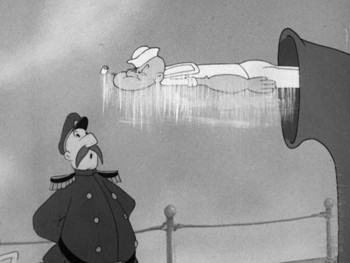
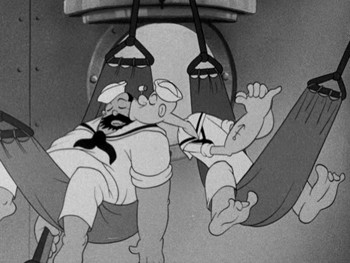
Jamie S. Rich is a novelist and comic book writer. He is best known for his collaborations with Joelle Jones, including the hardboiled crime comic book You Have Killed Me, the challenging romance 12 Reasons Why I Love Her, and the 2007 prose novel Have You Seen the Horizon Lately?, for which Jones did the cover. All three were published by Oni Press. His most recent projects include the futuristic romance A Boy and a Girl with Natalie Nourigat; Archer Coe and the Thousand Natural Shocks, a loopy crime tale drawn by Dan Christensen; and the horror miniseries Madame Frankenstein, a collaboration with Megan Levens. Follow Rich's blog at Confessions123.com.
|
| Popular Reviews |
| Sponsored Links |
|
|
| Sponsored Links |
|
|
| Release List | Reviews | Shop | Newsletter | Forum | DVD Giveaways | Blu-Ray | Advertise |
|
Copyright 2024 DVDTalk.com All Rights Reserved. Legal Info, Privacy Policy, Terms of Use,
Manage Preferences,
Your Privacy Choices | |||||||









